Mysteries of the Mycorrhizae
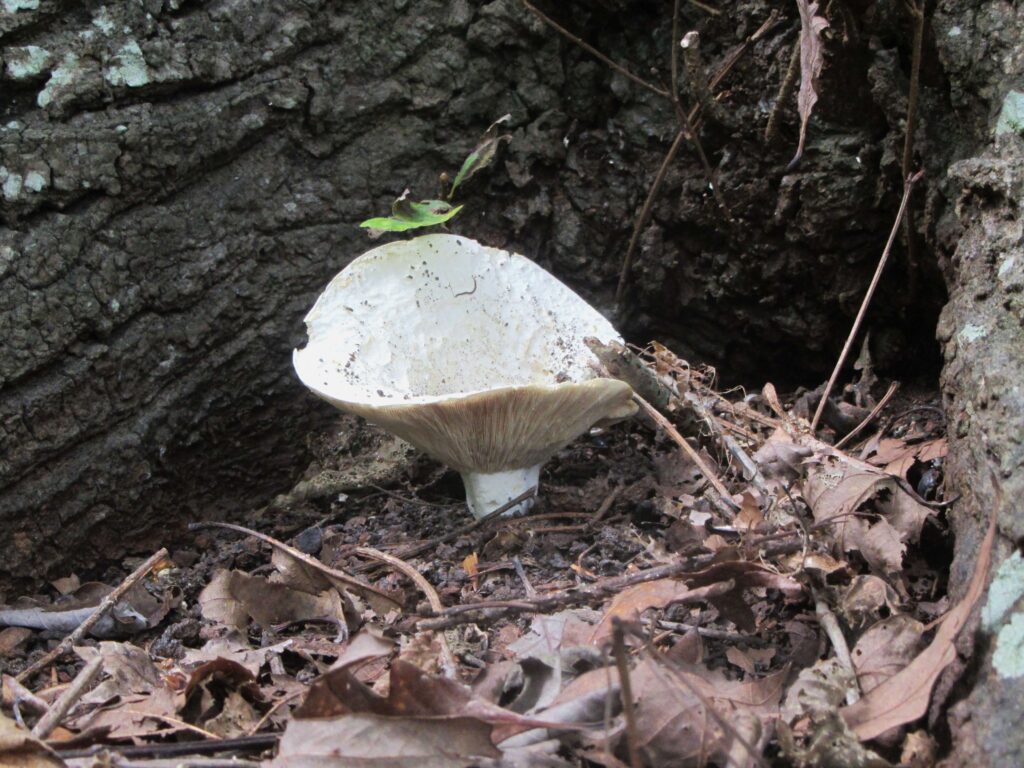
This mushroom appeared after a heavy rain in early August. It may be Russula brevipes, known as short-stemmed Russula.
“To use the world well,
To be able to stop
wasting it and our time in it,
we need to relearn our being in it.”
Ursula Le Guin
A friend and I were chatting about recipes one afternoon. She is a talented cook and loves to feed her friends and loved ones. I asked for the recipe for something delicious she had served, and she avoided disclosing the details. Finally, she gently explained that among her family, no one ever shared the complete recipe for a favorite dish. Everyone kept their secrets. She had learned from her mother and aunties, if pushed to disclose a recipe, to always leave out those key ingredients that conjured its unique goodness, so no one could copy their signature specialties.
Mother Nature’s Secret Ingredient
It seems that Mother Nature takes that same approach with nurturing plants. Her secret ingredient is mycorrhizal (my-kor-rise’-uhl) fungi. Myco has to do with fungi, and rhiza has to do with roots. These tiny, mostly hidden organisms help roots to grow better plants, among so many other environmental miracles. A plant growing in a symbiotic association with its fungi is called a mycorrhiza.
Yet instructions for how to grow a plant, whether a tomato or an oak tree, generally cover light and water needs, how often to fertilize, soil pH, and the plant’s sensitivity to cold. The mycorrhizal network in the soil which links plants one to another, and extends the reach of their roots, is the magic ingredient for plant vigor that few gardeners discuss.
Read the Quick Notes of Mysteries of the Mycorrhizae
The Living Kingdoms
For most of human history, we spoke of the Animal Kingdom and the Plant Kingdom of living things. There is also a Mineral Kingdom, but that is another tale for another day. The animals eat the plants, and their manure is spread as fertilizer. Life was simple. Then a third kingdom of single-celled organisms, Protista, was introduced in the mid-19th century. Microscopes weren’t yet powerful enough to illuminate the many differences in cell structures of these tiny living organisms. As optics improved, it became clear that some of organisms were not quite plants, but also not quite animals, and things got confusing. In 1969, Robert Whittaker proposed the Fungi Kingdom.
Now, molecular biology allows scientists to study life in ever more detail, and the official kingdoms have proliferated even further. In fact, scientists now know that fungal organisms have more in common with animals than they do with plants, and researchers have determined that fungi preceded both plants and animals in the history of life out of the oceans on Earth.
Symbiotic Evolution
When life first arose from the oceans, more than 450 million years ago, early aquatic plant life had chlorophyll, to make carbohydrates from sunlight, but they had no roots. As the earliest plants moved out of the oceans and onto dry land they partnered with fungi, which had hyphae (high’-fee) and could channel water and minerals into plant cells in exchange for sugars. We still see this relationship alive and thriving in lichens, one of the earliest organisms still alive and growing today. Lichens is a symbiotic relationship between algae and fungus. The fungus gives the lichens structure and form, and a means to reproduce. The algae, sometimes more than one algal species, produces food for itself and for the fungi. It also often provides blue or green color to the symbiotic pair.
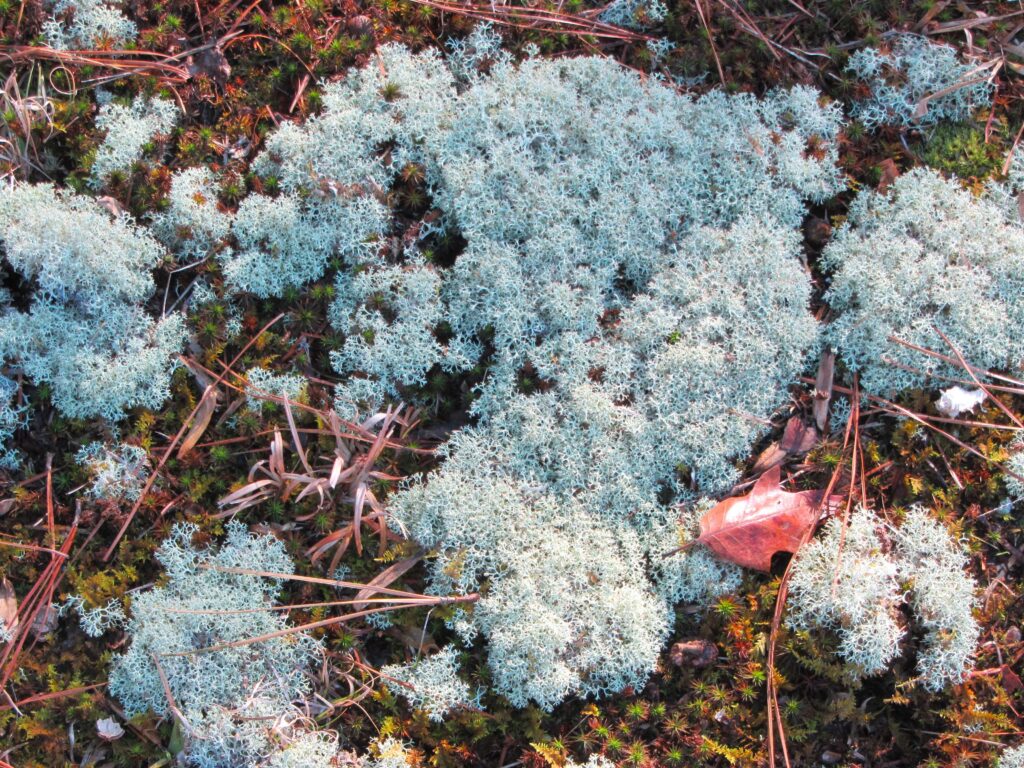
Blue-green reindeer lichen, Cladonia subtenuis, is a type of lichens common in our area. It is growing with starburst moss, Atrichum angustatum.
Until plants developed enough to have vascular roots or non-vascular rhizoids, as in moss, they could only survive in symbiosis with fungi. They needed fungi to keep plant cells hydrated and supplied with minerals. That relationship continues to this day in over 90% of plant species because they depend on mycorrhizal fungi to assist their roots in accessing water and minerals from the environment. Plants also rely on fungi of all sorts to create soil from rock and other organic matter.
The Mycorrhizae Hypothesis
German botanist and mycologist Albert Bernard Frank coined the term ‘mycorrhizae’ to discuss the symbiotic relationship between fungi and green plants in a paper he published in Germany in 1885. He had already introduced the term ‘symbiotic’ in 1877 to describe the relationship between algae and fungus in lichens. His work was not well-received at the time but has since been proven correct.
Fungi share in the abundance of sugars and other carbon-based phytochemicals produced by a growing plant each day. They use carbohydrates absorbed from a plants’ roots for their own metabolism while also ‘sharing’ those sugars with other plants. Mycorrhizal fungi share carbohydrates with seedlings growing in the shade of a mother plant, and also with other plants of totally different species growing nearby which are linked into the same network of mycelium (my-see’-lee-uhm). In exchange for the carbohydrates, they channel water, nitrogen, and other nutrients to all of the plants in their network.
There are even flowering plants, like Monotropa, Indian-pipes, which lack chlorophyll and leaves altogether. We now know that mycelium ‘feed’ these species the carbohydrates they need, harvested from the roots of nearby trees. Orchids, wildflowers and tree seedlings growing in deep shade depend on sugars produced by trees with canopies in the sunlight that can produce enough food to grow and sustain themselves while also sustaining plants growing in their shade. Some orchids need this feeding assist only when young, but many orchid species rely on shared carbohydrates throughout their lives. This is a reason why ‘wildflowers’ that well-meaning gardeners dig in the forest and transplant to their own yards may not survive. They have been removed from their supportive mycorrhizal network.
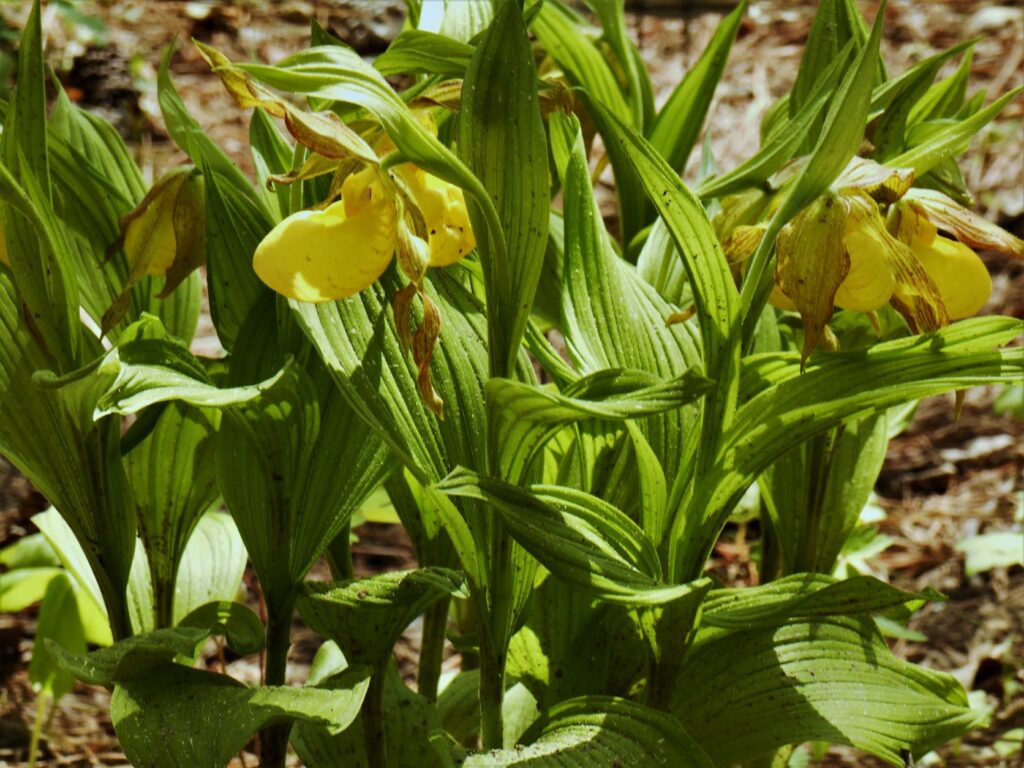
Cypripedium parviflorum, the yellow ladyslipper, depends on mycorrhizal fungi. It blooms in April here in the Calcareous Ravine at the Williamsburg Botanical Garden.
“The Wood Wide Web”
A single network of mycelium may link many different plants together, by interfacing with their roots, across many acres. This was first demonstrated in the laboratory in the early 1980s by English researcher Sir David Read, using radioactive carbon dioxide, and in the wild in the mid-1990s by Canadian doctoral student Suzanne Simard. Both researchers ‘fed’ the radioactive carbon to ‘donor’ tree seedlings and then documented the radioactive carbon showing up in the tissue of nearby tree seedlings, and also in the mycelium connecting them. Simard shaded some seedlings and left others in the sun to prove that trees growing in sunlight help support those that are shaded. So, Mother Nature held onto this vital secret about ‘The World Wide Web’ of symbiotic mycorrhizal relationships up until about 30 years ago.
A mycorrhizal fungus living in the soil looks like a network of slender threads, most too small to see without magnification. These delicate tubes, whose walls are a single cell thick, are known as mycelium. Feathery filaments which grow from the tips of mycelium cells are known as hyphae. These hyphae, whose cell walls are made from chitin, the same substance found in the exoskeletons of insects, both release enzymes to ‘digest’ organic matter, and they absorb those elements which are passed back to the plants’ roots. When hyphae anchor the organism and absorb water, they are known as rhizoids. Hyphae are strong enough to penetrate and disintegrate rock, which is how plants first gained a foothold on Earth in the distant past. The first soil accumulated from rock fragments and the decaying bodies of early plants and animals. That process continues today as rock is pulverized by mycelial hyphae and transformed into soil.
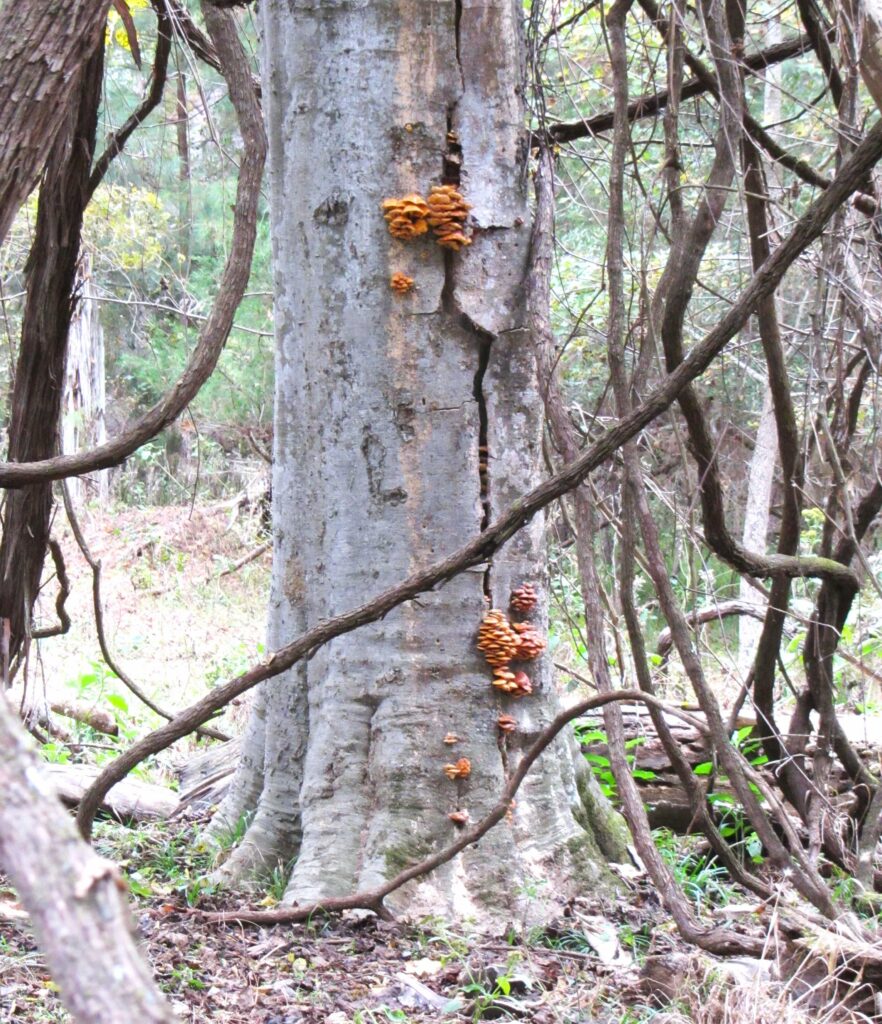
These may be honey mushrooms, Armillaria mellea, that have colonized a dying American beech tree on Jamestown Island.
The Proof Is in the Hyphae
Mycologists recognize two main groups of beneficial mycorrhizal fungi: those whose hyphae interact only with a root’s out layers, penetrating only between cell walls of the root tip’s cortex, and those whose hyphae penetrate cell walls and grow within the cells of a plant’s roots. These distinct groups of fungi are known as ectomycorrhizae and endomycorrhizae. There are further distinctions within both groups to describe how these fungi interact with plants.
The arbuscular mycorrhizae, a subgroup of endomycorrhizal fungi, interact with the roots of 80% or more of known plant species and are the fungi that helped plants make the leap to land from the oceans. Their network of hyphal growth within a plant cell, as seen under magnification, resembles a tree. Known as arbuscules, these bundles of branching hyphae within a root cell are responsible for the exchange of nutrients between the plant and the fungus. You probably won’t see these hyphal networks if you dig up a plant to examine its roots. Most of the fungal structures are too small to see without magnification.
Fungal Partnerships
A mycorrhizal fungus may live in harmony with several other species of fungus, all supporting and living harmoniously with a guild of trees, mosses, ferns, and other herbaceous plants. A colony of fungus may grow for several decades before it first produces spore bearing mushrooms. This causes some frustration for growers waiting for a harvest of truffles or other high value mushrooms.
Mushrooms sometimes appear very suddenly, with no warning, after a heavy summer rain. They were likely already there on their mycelium, just beneath the surface, waiting for the right conditions to ‘bloom.’ The cells of these fruiting bodies, spore-filled mushrooms, expand when soil moisture increases during rain. They swell up with moisture quickly, so they appear to suddenly ‘grow’ out of the lawn. Most mushrooms appear quickly and may also disintegrate quickly once they have released their spores.
While the fungus can grow ever larger underground, spores allow its genetic material to spread to another location and begin colonizing new ground. Spores may travel by wind or water, or they may be spread by animals. Since mushrooms provide important food for insects, birds, and many other types of animals, including fish; spores may be deposited miles away from the parent plant in an animal’s excrement. Some fungi don’t even produce mushrooms or puffballs, and so their spores may remain underground, sometimes spread by earthworms and other invertebrates.
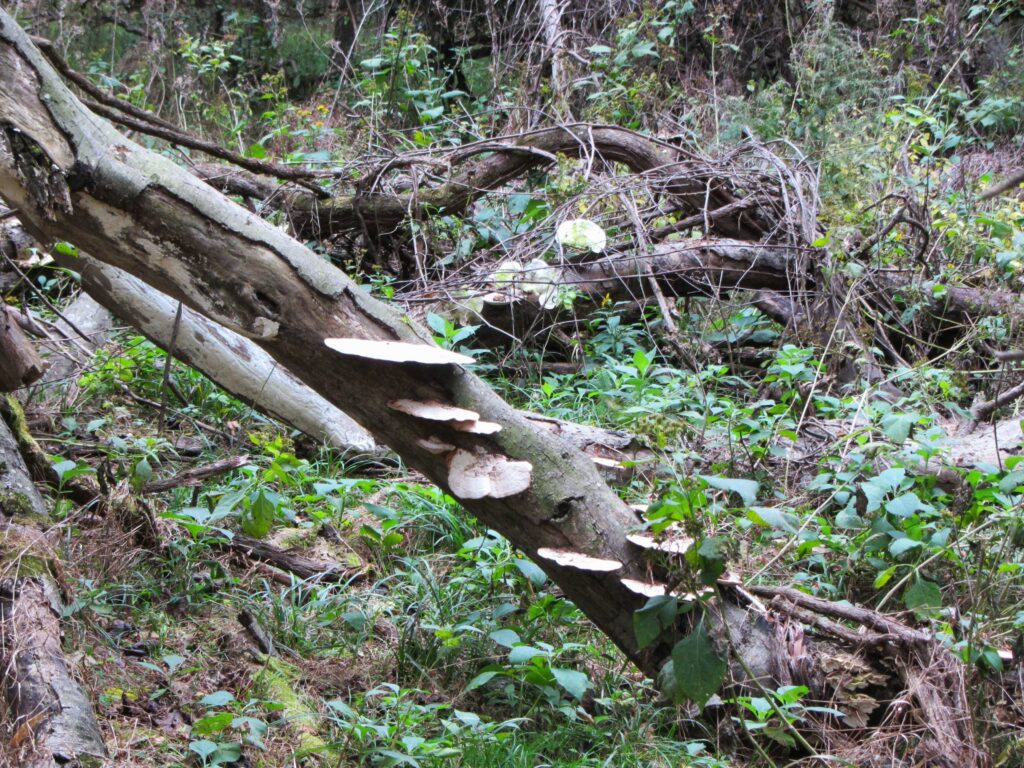
Mushrooms transform dead wood into living soil, recycling all of nature’s elements into new life. These mushrooms may be Dryad’s Saddle, Cerioporus squamosus. Jamestown Island
Giants Beneath Our Feet
Fungal organisms may be the largest living creatures on our planet, covering acres of land and weighing thousands of tons. A particularly large fungus organism, Armillaria, lives in eastern Oregon. In 2015 it already covered more than three square miles and weighed over 8000 tons. Mycologists estimate its age to be at least 8000 years. The only visible evidence of this underground organism is its honey-colored fruiting bodies, mushrooms, which appear each autumn, and its network of mycelium that can be found in the soil and sometimes under the bark of trees it has attacked. This, unfortunately, is a tree-killing fungus which affects some species and not others. It values the forest over the individual trees. Dying trees become homes for wildlife and make room for new trees to grow. By consuming the trees, it renews and enriches the soil for the next crop of future vegetation.
“The transformational power of yeast has long been personified as a divine energy, spirit or god.
… An invisible force conjures wine from fruit, beer from grain, mead from nectar. These liquids alter our minds and have been enfolded withing human cultures in many ways…”
Rupert Sheldrake, from Entangled Life
Agents of Transformation
Like so many things in life, fungi can be bad or good, depending on your point of view; hurtful or helpful depending on your interests. Fungi, in the form of yeasts, inspired agriculture and permanent communities when early humans learned to transform grains into both beer and bread. Fungi is a catalyst for change, for transforming one thing into another. It breaks down organic molecules to transform them, freeing up elements to re-combine for other uses.

Turkey tail mushrooms, Trametes versicolor, are common in Virginia and are most often found growing on dead wood. They are not parasites, but they are primary decomposers.
Fungi have already proven their ability to break down and recycle modern waste products like cigarette butts; used diapers; agricultural waste; some plastics; toxic waste of many types including chemical weapons; heavy metal contamination in soil; and there may even be fungal species that can process nuclear waste to render it harmless.
Just as some types of fungi cause disease and discomfort in humans, as well as in certain animals and plants, others support and sustain healthy growth. Fungi give us antibiotics and other life-saving drugs. Fungi living in our bodies protect us from many diseases. Fungi and fungi spores are so abundant and diverse that each of us harbors multiple fungal genera on our bodies. We inhale fungal spores with each breath we take, particularly when we are outdoors, and they are present on many foods.
There are several different types of fungus, each with its own niche within the ecosystem. Some are parasites, and some are decomposers which consume organic material already killed and decomposed by other fungal species. The fungal genera gardeners depend upon to help support plants are symbiotic mycelium species which work cooperatively with plants for the good of the entire plant community. A seedling plant supported by mycelium grows faster and stronger than one grown in sterile potting mix. The mycelium give it resistance to certain microbial infections and feed essential nutrients to young plants that a commercial fertilizer cannot replace.

This may be an artist’s bracket, Ganoderma applanatum, which is one of the largest mushrooms growing in Virginia.
Mycorrhizal fungi provide these ecological services within the environments where they grow:
Mychorrhizal fungi:
- Increase the absorption surface of plant roots to seek water from soil distant from the plant
- Seek and transport phosphorus, ammonium, zinc, nitrogen, and other nutrients back to those plants that need them.
- Sequester carbon captured by plants’ leaves within the structure of mycelium in the soil.
- Improve soil texture and its ability to absorb and hold water.
- Provide for communication between plants about environmental stressors via chemical messaging
- Protect plants from certain soil-borne diseases
- Help plants withstand stressors like drought, excessive heat, salinity, and toxic waste build-up in the soil
- Decompose leaf litter, dead wood, insects, and other dead organisms to build rich soil and free up nutrients for plant growth
- Provide structure for healthy soil and protect it from erosion
- Feed insects, birds, reptiles, mammals, and humans
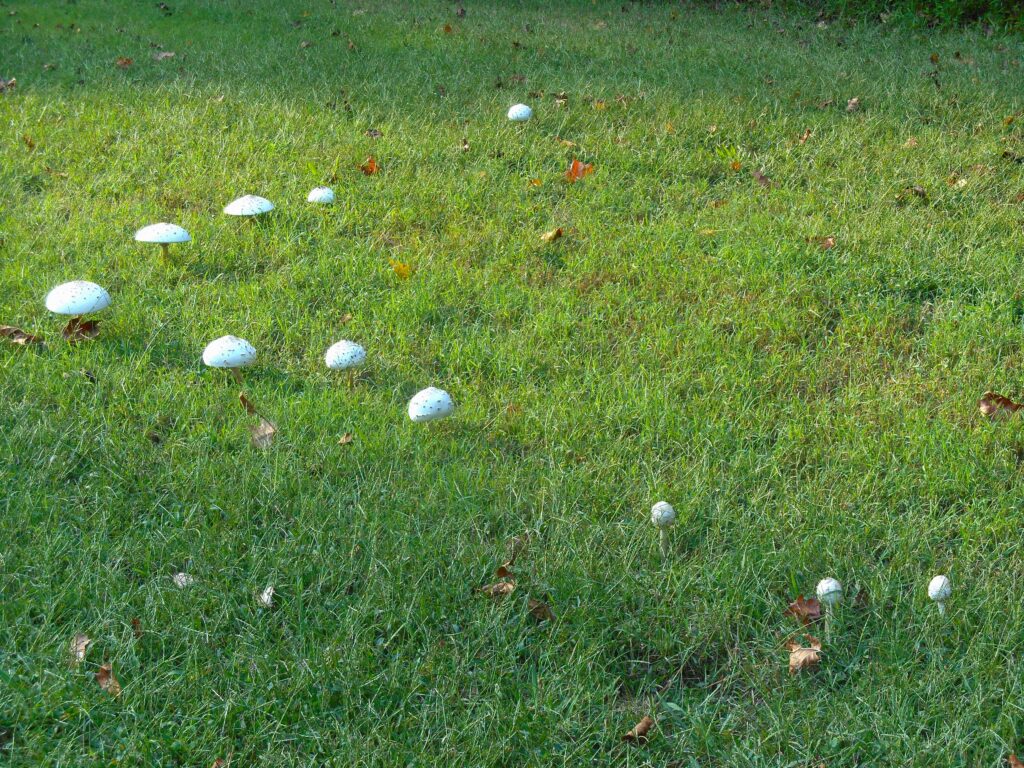
Mushrooms often sprout quite suddenly after a heavy rain in late summer and early fall, evidence of the network of mycelium running through the soil.
Mother Nature’s Way
When one of our plants is struggling, most of us want to know which chemicals to apply to solve the problem. Now we are beginning to understand that most pesticides and strong fertilizers kill mycorrhizal fungi in the soil. When we apply fungicides to address black spot or powdery mildew, that fungicide will also kill beneficial fungus which may be supporting the plant’s roots. Keep in mind that insecticides and herbicides can also kill the symbiotic fungi our plants depend upon for their health.
We also disrupt the network of mycelium when we till and double dig the soil. We are encouraged to disturb the soil as little as possible to preserve the network of mycelium connecting plants, and to protect other organisms living in the soil. Farmers have been working with cover crops and no-till planting methods for decades now to improve their soil’s health and to prevent erosion and carbon loss.
Mulch for Mycorrhizae
Home gardeners know that mulch improves plant health, but we may not realize the importance of mulch in establishing and sustaining mycorrhizal fungi around shrubs and in our perennial beds. Wood chips and bark mulches often introduce beneficial spores that help fungal communities to establish, and they also protect the soil as the mycelium grows. The practice of ‘chop and drop,’ which leaves cut down weeds in place as mulch, further feeds the soil. The weeds must be chopped before they set seeds for this method to work, of course.
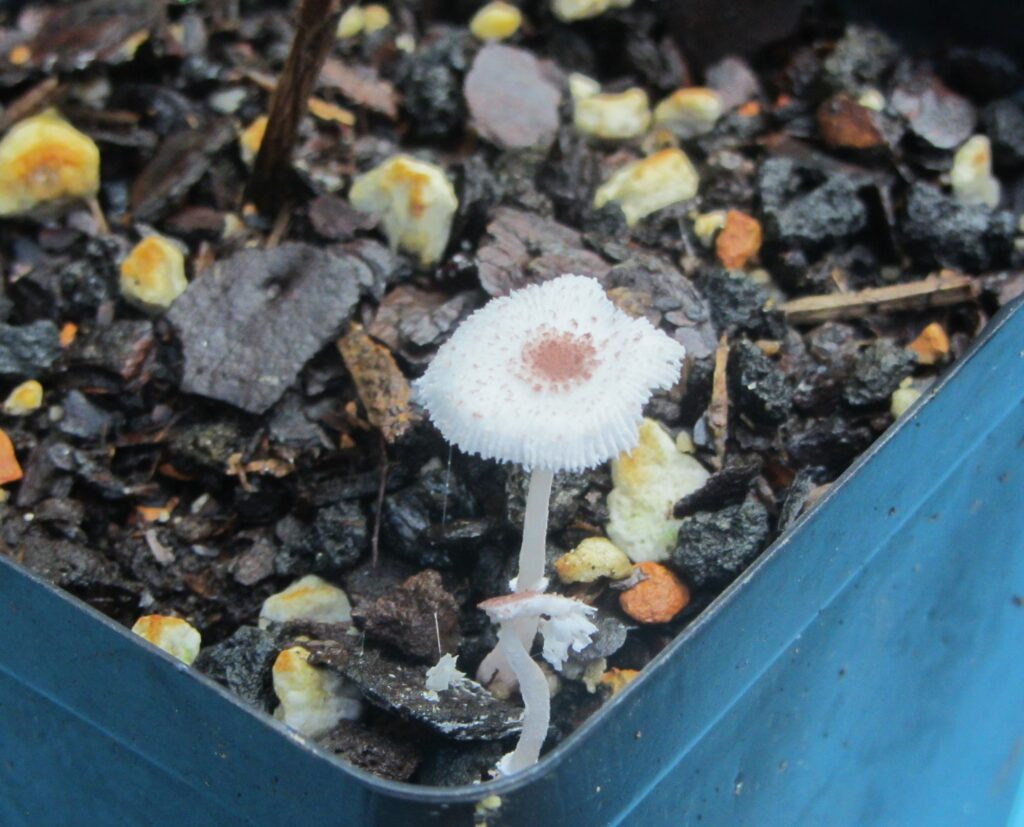
Finding mushrooms growing with a seedling demonstrates that there is mycelium assisting the seedling’s growth. This is a positive sign and not a cause for concern. Potting mix inoculated with mycorrhizal spores gives young plants a boost.
To Inoculate with Active Spores, or Not?
Mycologists have learned that ‘inoculating’ a seed or seedling with mycorrhizal fungi both improves its growth and may also help establish a colony of desirable mushrooms around a seedling tree as it grows. There are a few different ways to inoculate a plant’s roots with spores. A mature mushroom of the desirable species can be chopped up, added to a large bucket of water and mixed well, before bare root seedling trees or shrubs are dipped into this mix. Spores will stick to the roots and begin to grow into mycelium once the tree is planted. Use this water to irrigate large container grown plants to introduce beneficial fungi to the potting mix.
When farmers want to expand a colony of high value mushrooms, like truffles or chanterelles, they plant a seedling tree of the appropriate host species near an established patch of mushrooms and leave it in place for a year or two. Later, they dig the young tree and transplant it where it can mature. By then, it should have the appropriate mycelium growing around its roots.
Likewise, it may be enough to gather a few handfuls of rich, native soil from under established trees and shrubs similar to ones you want to grow and add it to the back fill when planting a tree, or spread it on the soil surface around a young tree. This established soil likely contains spores and mycelium that will grow and interact with the new trees you are planting. This is especially important when planting Ericaceae family plants like blueberries, Rhododendrons, and mountain laurels which grow in poor, acidic soils with low fertility.
Since fungal spores are widespread, those needed may already be present in the soil, ready to work with newly installed plants. A lot depends on the quality of your soil, how it has been handled in the past, and whether the native topsoil was recently scraped away for new construction. While adding organic matter always helps, many products are designed to introduce beneficial fungi to support crops and landscaping plants. Likewise, when blending a ‘seed starting mix,’ consider adding a commercial inoculant so seedlings have beneficial fungi ready to partner with them as they germinate. This will produce a stronger seedling with a better root system that will experience less transplant shock when it is moved out to the garden.
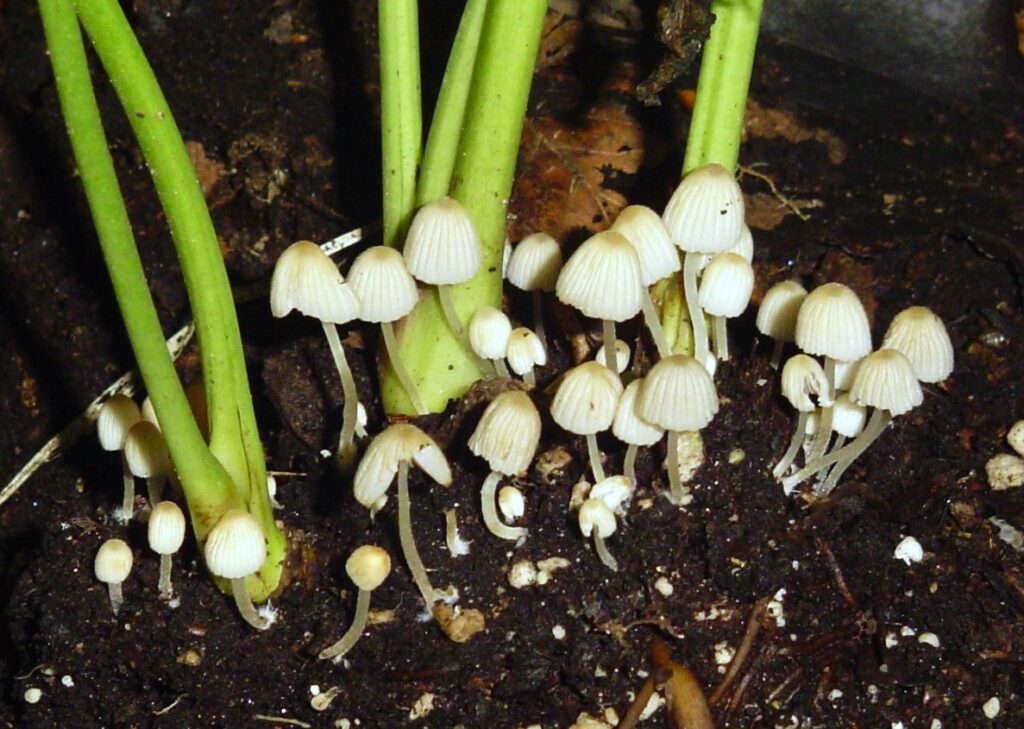
These may be Mica’s Cap, Coprinellus micaceus, mushrooms. They ‘auto-digest’ soon after you pick them.
Products to Establish a Fungal Community in Your Soil
There are a variety of commercial products which contain appropriate mycorrhizal spores. Some are mixed with various types of fertilizer, and some are designed specifically to inoculate woody roots or vegetable seeds before planting. Most of these products are sold to help plants establish faster, grow larger and stronger, and to withstand environmental stresses. When using these products, keep in mind that most include spores, not already established mycelium. When we can begin with desirable mycelium already growing around the same or a similar plant, we start off ahead.
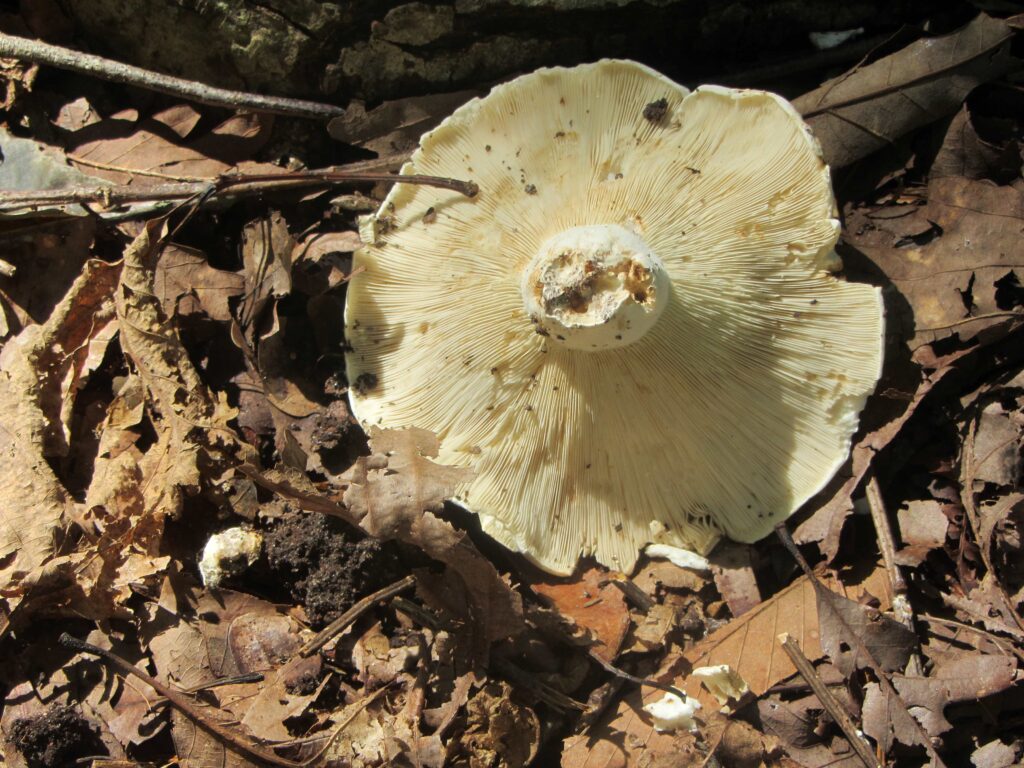
Spores are produced in a mushroom’s gills. Collect them by placing the mushroom cap gill side down on a sheet of paper, and waiting a few hours for the spores to release. Each species has it own signature spore pattern and color, which helps in positively identifying a mushroom by species. If making a water based inoculant, cut the gills away from the cap, chop them finely, and mix them into a bucket of water.
Discovering the Vast Kingdom of Fungi
Mycology, the study of fungal life, is a vast and complex field of study. Fungus and mushrooms can both nurture and kill. There are highly poisonous mushrooms we should never harvest to eat and there are hundreds of medicinal mushrooms used to cure various ills over many centuries. Some mushrooms yield top dollar at market as gourmet delicacies, while others taste terrible, even if they aren’t poisonous. Some mushrooms affect our brain chemistry and open our perceptions to new possibilities. Psychedelic fungal substances have been used since ancient times by shamans, priests, and priestesses of many indigenous traditions.
To work in cooperation with the vast networks of fungus likely already growing under our feet, we need to first recognize their existence, and then learn more about them. We can learn to recognize which are beneficial as we also learn to recognize those that may be harmful to the plants we grow.
Most of us know little or nothing about the vast Kingdom of Fungi, and how they support our well-being while they also support most of the plants growing in our gardens because this is a relatively new field. Just imagine how much more there is to discover, as Mother Nature continues to reveal more of her secrets.
“Our hands imbibe like
roots, so I place them
on what is beautiful in this world.”
Saint Francis of Assisi
All photos by E. L. McCoy
This article is for information only and is not intended to encourage anyone to ingest mushrooms, unless under the guidance of an expert mycologist who can identify them. Mushrooms may look very much alike and have vastly different chemical properties. Identification of species in this article is a ‘best guess’ based on available resources.
Quick Notes: Mysteries of the Mycorrhizae
For More Information:
Elliot, Todd F. and Steven L. Stephenson. Mushrooms of the Southeast. Timber Press. 2018.
McKnight, Karl B.,
Phillips, Michael. Mycorrhizal Planet: How Symbiotic Fungi Work with Roots to Support Plant Health and Build Soil Fertility. Chelsea Green Publishing. 2017.
Sheldrake, Rupert. Entangled Life: How Fungi Make Our Worlds, Change Our Minds & Shape Our Futures. Random House. 2020.
Smith, Sally E. and David J. Read. Mycorrhizal Symbiosis 3rd Edition. Academic Press. 2008.
Stamets, Paul. Mycelium Running: How Mushrooms Can Help Save the World. Ten Speed Press. 2005.
Zonca, Vincent. Lichens: Toward a Minimal Resistance 1st Edition. Polity. 2022.











